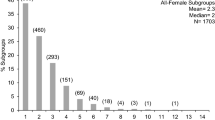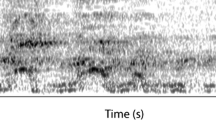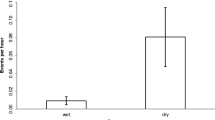Abstract
Sexual segregation is a recognized dimension of the socioecology of many vertebrates, but it has not been systematically examined in primates. We investigated temporal patterns of sexual segregation in spider monkeys (Ateles geoffroyi yucatanensis) using a test that distinguishes sexual segregation from aggregation and random association between the sexes. We further investigated how sexual segregation varies over time as a function of food availability, and then tested other possible factors that might be causally linked to sexual segregation in spider monkeys. We predicted that male philopatry and cooperative territorial defence leads to sexual dimorphism in behavior, which in turn creates different optimal energetic requirements for males and females as reflected in differing activity budgets and diet. We investigated sexual segregation in a group of 33–35 spider monkeys at Runaway Creek Nature Reserve in Belize over 23 mo in 2008–2009. We used the sex compositions of subgroups recorded in scan samples to test the occurrence of sexual segregation at monthly and biweekly time scales.We found that males and females were significantly segregated in 15 out of the 23 mo of the study, and that periods of nonsegregation coincided with months of low food availability. The sexes differed significantly in activity and diet; males spent more time traveling, and less time resting and feeding than females, and they had a higher proportion of ripe fruits in their diets than did females. We propose that sexual segregation in spider monkeys is primarily a form of social segregation that results from males and females pursuing optimal dietary and behavioral strategies to satisfy sex-specific energetic demands. We further suggest that sexual segregation represents an important constraint on fission–fusion dynamics that should be considered when assessing the potential for variability in subgroup composition.





Similar content being viewed by others
References
Aureli, F., Schaffner, C. M., Boesch, C., Bearder, S. K., Call, J., Chapman, C. A., et al. (2008). Fission-fusion dynamics. Current Anthropology, 49, 627–654.
Boesch, C. (1996). Social grouping in Taï chimpanzees. In W. C. McGrew, L. F. Marchant, & T. Nishida (Eds.), Great ape societies (pp. 101–113). Cambridge, U.K: Cambridge University Press.
Bon, R. (1991). Social and spatial segregation of males and females in polygamous ungulates: Proximate factors. In F. Spitz, G. Janeau, G. Gonzalez, & S. Aulagnier (Eds.), Ongules/ungulates (pp. 195–198). Paris/Toulouse: SFEPM-IRGM.
Bonenfant, C., Gaillard, J., Dray, S., Loison, A., Royer, M., & Chessel, D. (2007). Testing sexual segregation: old ways are best. Ecology, 88, 3202–3208.
Bowyer, R. T. (2004). Sexual segregation in ruminants: definitions, hypotheses, and implications for conservation and management. Journal of Mammalogy, 85, 1039–1052.
Bowyer, T. R., Kie, J. G., & Van Ballenberghe, V. (1996). Sexual segregation in black-tailed deer: effect of scale. Journal of Wildlife Management, 60, 10–17.
Campbell, C. J. (2003). Female-directed aggression in free-ranging Ateles geoffroyi. International Journal of Primatology, 24, 223–237.
Campbell, C. J., & Gibson, K. N. (2008). Spider monkey reproduction and sexual behavior. In J. C. Campbell (Ed.), Spider monkeys: Behavior,ecology,and evolution of the genus Ateles (pp. 266–287). New York: Cambridge University Press.
Chapman, C. A. (1990). Association patterns of spider monkeys: the influence of ecology and sex on social organization. Behavioural Ecology and Sociobiology, 26, 409–414.
Clutton-Brock, T. H. (1983). Selection in relation to sex. In D. S. Bendall (Ed.), Evolution from molecules to men (pp. 457–481). Cambridge, U.K: Cambridge University Press.
Clutton-Brock, T. H., Iason, G. R., Albon, S. D., & Guiness, F. E. (1982). Effects of lactation on feeding behaviour and habitat use in wild red deer hinds. Journal of Zoology, 198, 227–236.
Conradt, L. (1998). Could asynchrony in activity between the sexes cause intersexual social segregation in ruminant? Proceedings of the Royal Society of London B: Biological Sciences, 265, 1359–1363.
Conradt, L. (1999). Social segregation is not a consequence of habitat segregation in red deer and feral soay sheep. Animal Behaviour, 57, 1151–1157.
Conradt, L., Clutton-Brock, T. H., & Guinness, F. E. (2000). Sex differences in weather sensitivity can cause habitat segregation: Red deer as an example. Animal Behaviour, 59, 1049–1060.
Conradt, L., & Roper, T. J. (2000). Activity synchrony and social cohesion: a fission-fusion model. Proceedings of the Royal Society of London B: Biological Sciences, 267, 2213–2218.
Cook, T. R., Cherel, Y., Bost, C. A., & Tremblayz, M. (2007). Chick-rearing Crozet shags (Phalacrocorax melanogenis) display sex-specific foraging behaviour. Antarctic Science, 19, 55–63.
Darden, S. K., James, R., Ramnarine, I. W., & Croft, D. P. (2009). Social implications of the battle of the sexes: sexual harassment disrupts female sociality and social recognition. Proceedings of the Royal Society of London B: Biological Sciences, 276, 2651–2656.
Darwin, C. (1871). The descent of man, and selection in relation to sex (1st ed.). London: John Murray.
Di Fiore, A., & Campbell, C. J. (2007). The Atelines: Variation in ecology, behavior, and social organization. In C. J. Campbell, S. Bearder, A. Fuentes, K. C. MacKinnon, & M. Panger (Eds.), Primates in perspective (pp. 155–185). New York: Oxford University Press.
Di Fiore, A., Link, A., Spehar, S. N., & Schmitt, C. A. (2009). Dispersal patterns in sympatric woolly and spider monkeys: integrating molecular and observational data. Behaviour, 146, 437–470.
Eisenberg, J. F. (1973). Reproduction in two species of spider monkeys, Ateles fusciceps and Ateles geoffroyi. Journal of Mammalogy, 54, 955–957.
Evans, K. J., Pavelka, M. S., Hartwell, K. S., & Notman, H. (2012). Do adult male spider monkeys (Atelesgeoffroyi) preferentially handle male infants? International Journal of Primatology, 33, 799–808.
Fedigan, L. M. (1992). Primate paradigms: Sex roles and social bonds. Chicago: University of Chicago Press.
Fedigan, L. M., & Baxter, M. J. (1984). Sex differences and social organization in free-ranging spider monkeys (Ateles geoffroyi). Primates, 25, 279–294.
Goodall, J. (1986). The chimpanzees of Gombe: Patterns of behavior. Cambridge, MA: Harvard University Press.
Key, C., & Ross, C. (1999). Sex differences in energy expenditure in non-human primates. Proceedings of the Royal Society of London B: Biological Sciences, 266, 2479–2485.
Knott, C. D. (1999). Reproductive,physiological and behavioral responses of orangutans in Borneo to fluctuations in food availability. PhD dissertation, Harvard University, Cambridge, MA.
Link, A., Di Fiore, A., & Spehar, S. N. (2009). Female directed aggression and social control in spider monkeys. In M. N. Muller & R. W. Wrangham (Eds.), Sexual coercion in primates and humans: An evolutionary perspective on male aggression against females (pp. 157–187). Cambridge, MA: Harvard University Press.
Loe, L. E., Irvine, R. J., Bonenfant, C., Stien, A., Langvatn, R., Albon, S. D., et al. (2006). Testing five hypotheses of sexual segregation in an arctic ungulate. Journal of Animal Ecology, 75, 485–496.
Main, M. B., Weckerly, F. W., & Bleich, V. C. (1996). Sexual segregation in ungulates: new directions for research. Journal of Mammalogy, 77, 449–461.
Matsumoto-Oda, A., Hosaka, K., Huffman, M. A., & Kawanaka, K. (1998). Factors affecting party size in chimpanzees of the Mahale mountains. International Journal of Primatology, 19, 999–1011.
McCullough, D., Hirth, D., & Newhouse, S. (1989). Resource partitioning between the sexes in white-tailed deer. Journal of Wildlife Management, 53, 277–283.
Meerman, J. C. (1999). Rapid ecological assessment of Runaway Creek. Belize: Zoological Society of Milwaukee.
Milton, K. (1981). Estimates of reproductive parameters for free-ranging Ateles geoffroyi. Primates, 22, 574–579.
Newton-Fisher, N. E., Reynolds, V., & Plumptre, A. J. (2000). Food supply and chimpanzee (Pan troglodytes schweinfurthii) party size in the Budongo Forest Reserve, Uganda. International Journal of Primatology, 21, 613–628.
Pellegrini, A. D., & Long, J. D. (2003). A sexual selection theory longitudinal analysis of sexual segregation and integration in early adolescence. Journal of Experimental Child Psychology, 85, 257–278.
Ramos-Fernandez, G. (2005). Vocal communication in a fission-fusion society: Do spider monkeys stay in touch with close associates? International Journal of Primatology, 26, 1077–1092.
Ramos-Fernandez, G., Boyer, D., Aureli, F., & Vick, L. G. (2009). Association networks in spider monkeys (Ateles geoffroyi). Behavioural Ecology and Sociobiology, 63, 999–1013.
Ren, B., Li, D., Garber, P. A., & Li, M. (2012). Fission–fusion behavior in Yunnan snub-nosed monkeys (Rhinopithecus bieti) in Yunnan, China. International Journal of Primatology, 33, 1–14.
Ruckstuhl, K. E. (1998). Foraging behaviour and sexual segregation in bighorn sheep. Animal Behaviour, 55, 99–106.
Ruckstuhl, K. E. (2007). Sexual segregation in vertebrates: proximate and ultimate causes. Integrative and Comparative Biology, 47, 245–257.
Ruckstuhl, K. E., & Neuhaus, P. (2000). Sexual segregation in ungulates: a new approach. Behaviour, 137, 361–377.
Ruckstuhl, K. E., & Neuhaus, P. (2002). Sexual segregation in ungulates: a comparative test of three hypotheses. Biological Reviews of the Cambridge Philosophical Society, 77, 77–96.
Ruckstuhl, K. E., & Neuhaus, P. (2005). Sexual segregation in vertebrates: Ecology of the two sexes. New York: Cambridge University Press.
Sakura, O. (1994). Factors affecting party size and composition of chimpanzees (Pan troglodytes verus) Bossou, Guinea. International Journal of Primatology, 15, 167–183.
Shimooka, Y. (2005). Sexual differences in ranging of Ateles belzebuth belzebuth at La Macarena, Colombia. International Journal of Primatology, 26, 385–406.
Shimooka, Y., Campbell, C., Di Fiore, A., Felton, A. M., Izawa, K., Link, A., & Wallace, R. (2008). Demography and group composition of Ateles. In J. C. Campbell (Ed.), Spider monkeys: Behavior,ecology,and evolution of the genus Ateles (pp. 329–348). New York: Cambridge University Press.
Silk, J. B. (1999). Why are infants so attractive to others? The form and function of infant handling in bonnet macaques. Animal Behaviour, 57, 1021–1032.
Singh, N. J., Bonenfant, C., Yoccoz, N. G., & Cote, S. D. (2010). Sexual segregation in Eurasian wild sheep. Behavioral Ecology, 21, 410–418.
Slater, K. Y., Schaffner, C. M., & Aureli, F. (2007). Embraces for infant handling in spider monkeys: evidence for a biological market? Animal Behaviour, 74, 455–461.
Slater, K. Y., Schaffner, C. M., & Aureli, F. (2009). Sex differences in the social behavior of wild spider monkeys (Ateles geoffroyi yucatanensis). American Journal of Primatology, 71, 21–29.
Spehar, S. N., Link, A., & Di Fiore, A. (2010). Male and female range use in a group of white-bellied spider monkeys (Ateles belzebuth) in Yasuni National Park, Ecuador. American Journal of Primatology, 72, 129–141.
Stanford, C. B., Wallis, J., Mpongo, E., & Goodall, J. (1994). Hunting decisions in wild chimpanzees. Behaviour, 131, 1–18.
Stokke, S. (1999). Sex differences in feeding-patch choice in a megaherbivore: elephants in Chobe National Park, Botswana. Canadian Journal of Zoology, 77, 1723–1732.
Stumpf, R. M. (2007). Chimpanzees and bonobos. In C. J. Campbell, S. Bearder, A. Fuentes, K. C. MacKinnon, & M. Panger (Eds.), Primates in perspective (pp. 321–344). Oxford: Oxford University Press.
Sueur, C., Jacobs, A., Amblard, F., Petit, O., & King, A. J. (2011). How can social network analysis improve the study of primate behavior? American Journal of Primatology, 73, 703–719.
Symington, M. M. (1988). Demography, ranging patterns, and activity budgets of black spider monkeys (Ateles paniscus chamek) in the Manu National Park, Peru. American Journal of Primatology, 15, 45–67.
Trivers, R. (1972). Parental investment and sexual selection. In B. Campbell (Ed.), Sexual selection and the descent of man: 1871–1971 (pp. 136–179). Chicago: Aldine.
Villaret, J. C., & Bon, R. (1995). Social and spatial segregation in Alpine ibex (Capra ibex) in Bargy, French Alps. Ethology, 101, 291–300.
Wallace, R. B. (2008). Factors influencing spider monkey habitat use and ranging patterns. In J. C. Campbell (Ed.), Spider monkeys: Behavior, ecology, and evolution of the genus Ateles (pp. 138–154). New York: Cambridge University Press.
Watts, D. P. (2005). Sexual segregation in non-human primates. In K. E. Ruckstuh & P. Neuhaus (Eds.), Sexual segregation in vertebrates: Ecology of the two sexes (pp. 327–347). New York: Cambridge University Press.
Whitehead, H., Waters, S., & Lyrholm, T. (1991). Social organization of female sperm whales and their offspring: constant companions and casual acquaintances. Behavioral Ecology and Sociobiology, 29, 385–389.
Wiens, J. A. (1989). Spatial scaling in ecology. Functional Ecology, 3, 385–397.
Wrangham, R. W. (1979). Sex differences in chimpanzee dispersion. In D. A. Hamburg & E. R. McCown (Eds.), The great apes (pp. 481–489). Menlo Park, CA: Benjamin/Cummings.
Wrangham, R. W., & Smuts, B. B. (1980). Sex differences in the behavioural ecology of chimpanzees in the Gombe National Park, Tanzania. Journal of Reproduction and Fertility, 28(Supplement), 13–31.
Xavier, J. C., Croxall, J. P., & Reid, K. (2003). Interannual variation in the diets of two albatross species breeding in South Georgia: implications for breeding performance. Ibis, 14, 593–610.
Young, D. D., & Cockcroft, V. G. (1994). Diet of common dolphins (Delphinus delphis) off the south-east coast of southern Africa – opportunism or specialization. Journal of Zoology, 234, 41–53.
Acknowledgments
Thanks to Dr. Gil and Lillian Boese from the Zoological Society of Milwaukee and the Foundation for Wildlife Conservation for permission to work in RCNR and Birds without Borders/Aves sin Fronteras for their ongoing support and assistance with this project. Stevan Reneau in particular spent hundreds of hours assisting in data collection. Sharon Matola of the Belize Zoo is responsible for initiating the discussions that led to the establishment of this project in 2007, and we thank the staff at the Belize Zoo and Tropical Education Center for ongoing assistance of all kinds.We thank Kathreen Ruckstuhl for putting us in touch with Christophe Bonenfant and launching what is proving to be a very productive collaboration. We also thank Brittany Dean for assisting in data collection. This research was supported by the Natural Sciences and Engineering Research Council of Canada, the National Geographic Society, the University of Calgary, and Athabasca University. We also thank two anonymous reviewers and the editor for their careful and thoughtful reviews and constructive feedback.
Author information
Authors and Affiliations
Corresponding author
Rights and permissions
About this article
Cite this article
Hartwell, K.S., Notman, H., Bonenfant, C. et al. Assessing the Occurrence of Sexual Segregation in Spider Monkeys (Ateles geoffroyi yucatanensis), Its Mechanisms and Function. Int J Primatol 35, 425–444 (2014). https://doi.org/10.1007/s10764-013-9746-0
Received:
Accepted:
Published:
Issue Date:
DOI: https://doi.org/10.1007/s10764-013-9746-0




